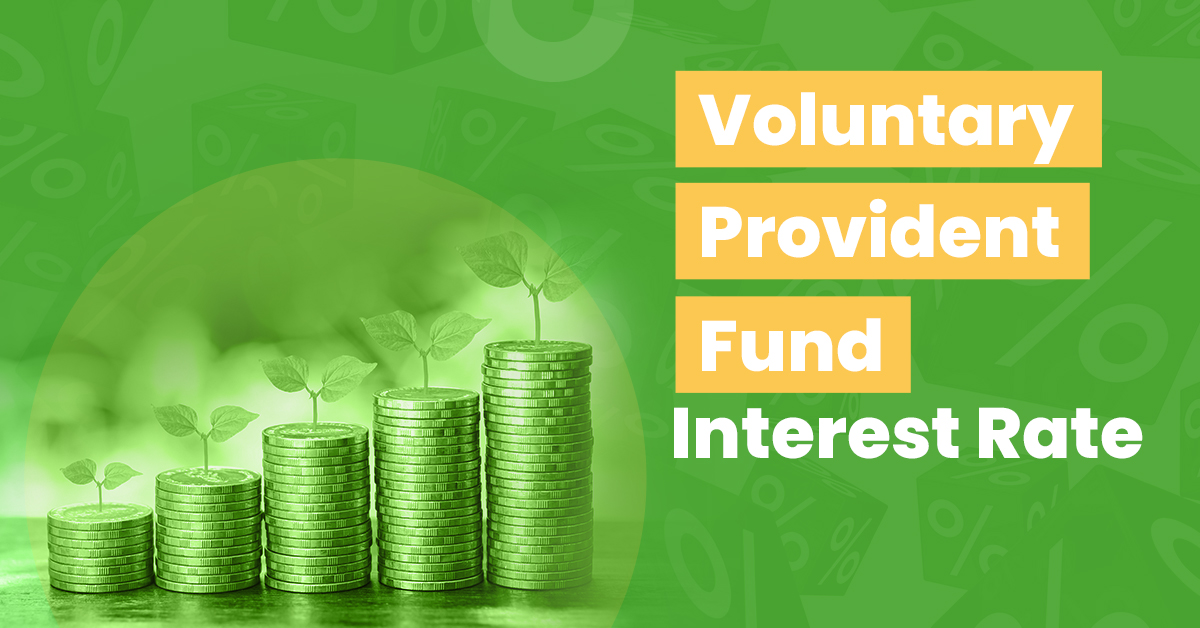VPF Interest Rate – Voluntary Provident Fund Calculation


The Employee Provident Fund (EPF) is a popular investment tool that helps salaried individuals build a retirement fund. The employer and employee contribute to the EPF monthly to ensure constant growth.
But often, due to contribution limits on EPF, it may not be enough to create a big enough corpus for your retirement. Remember, this corpus may be your only source of income once you retire.
If you are looking for a way to ramp up your EPFcontribution, a Voluntary Provident Fund (VPF) is an excellent option. VPF is an extension of the EPF scheme, where you can contribute monthly and enjoy all the benefits of EPF. But what is the VPF interest rate? Do VPF returns beat inflation? Let us learn more about VPF interest rate in this article.
What is a VPF Account?
EPF is a mandatory scheme for most corporate employees to ensure they create a solid corpus by the time they retire. As per the law, a minimum of 12% of your basic salary should be invested in the EPF account. The employer is also required to contribute a similar figure to your EPF account monthly.
However, if you want to create a bigger PF corpus, then there is an option where you contribute a sum voluntarily beyond the minimum limit set for your EPF account. This is called the Voluntary Provident Fund (VPF). In other words, it is your voluntary contribution toward your EPF account.
When you opt for VPF, you have the option to invest up to 100% of your basic salary and dearness allowance in your provident fund account. The VPF interest rate is the same as the EPF interest rate, and your contributions to VPF will enjoy similar benefits.
Since VPF is voluntary, you are not obligated to sign up for the same. But once you sign up and contribute, there is a five-year lock-in period. You can withdraw completely or partially before the lock-in period gets over under certain circumstances, but your corpus would attract income-tax.
Signing up for VPF is also easy. You have to contact your HR partner, and since you already have an EPF account running, the process would be simple, involving minimal paperwork. Right now, there is no way to start a VPF account without having an EPF account.
VPF Interest Rate
VPF is a low risk investment option. That is because VPF is not market-linked and hence safe from market volatilities. This makes VPF a conservative investment option.
But compared to other similar options, VPF offers higher returns. For FY 2023, VPF has an interest rate of 8.15%. This interest rate is revised every financial year by the government. In most cases, the interest rate offered manages to beat inflation.
The VPF return is entirely exempt from tax. Furthermore, you can avail of a tax deduction of up to Rs.1.5 lakh for your investment in VPF under Section 80C of the Income Tax Act.
Below is a table containing past VPF interest rates for comparative analysis.
| Year | Interest Rate |
| 2020-21 | 8.5% |
| 2019-20 | 8.5% |
| 2018-19 | 8.65% |
| 2017-18 | 8.55% |
| 2016-17 | 8.8% |
| 2015-16 | 8.8% |
| 2014-15 | 8.75% |
| 2013-14 | 8.75% |
How to Calculate VPF Interest Income?
As mentioned above, the VPF interest rates are revised yearly, and for FY 23, the interest rate is 8.15%. But how is interest income calculated? Let us find out.
The opening and closing balance of the VPF account are considered for calculating the interest income. The interest is calculated every month. Here, since VPF is an extension of EPF, the account balance is a total sum of EPF and VPF balance. This balance is credited to your EPF account at the end of every financial year.
One key factor that greatly helps your investment in VPF grow is compounding. In investment terms, compounding is when your VPF returns are reinvested into your corpus so that the compounded corpus grows nonlinearly.
For example, suppose you make Rs.100 as interest in your second month of VPF investment. This interest is reinvested into your original corpus, and the compounded corpus (current corpus + Rs.100) will start to accrue interest earnings from the next month. This may not have a significant effect in a shorter period, but it can accelerate your investment’s growth in the long term.
Conclusion
It is essential to understand an investment option’s return potential before investing. The same is true in the case of VPF too. VPF returns tend to be better than similar conservative options like Fixed Deposits or even PPF. But ensure that you compare the potential of VPF with your investment goals for the desired results.
FAQ about VPF Interest Rate
Can I withdraw funds from my VPF account?
VPF has a maturity period of five years. The fund will be locked till then. At maturity, you can withdraw the corpus completely tax-free. There is an option to withdraw funds before the lock-in period, but only under certain circumstances like illness in the family. If you withdraw wholly or partially before the lock-in period, your withdrawal will attract tax. .
Is VPF tax-free?
VPF is tax-free in most cases. Accrued interest and maturity amount are tax free when you withdraw only after the lock-in period of five years. However, if you withdraw before that, you have to pay tax on returns according to your tax bracket. Furthermore, you can avail tax deduction of Rs.1.5 lakh towards the contribution in VPF.
What is the maximum and minimum amount that can be invested in VPF?
There are no minimum and maximum contribution limits in the case of VPF. For EPF, 12% is the mandated limit. For VPF, which is the extension of EPF, you can contribute up to 100% of your basic salary and dearness allowance. But it has to be remembered that, unlike EPF, the employer contribution will not increase in tandem with your contribution.
Is it wise to invest in VPF?
VPF is a good option if you are a conservative investor looking to build a retirement corpus. The VPF interest rate is comparatively better than similar low-risk options. Moreover, the tax benefits make it an even more lucrative choice.
Which is better – PPF or VPF?
The decision to choose one of the two depends on your return expectations and investment horizon. The return rate for VPF for the current financial year is 8.1%, whereas the rate for PPF is 7.1%. Hence, contributing to VPF will allow you to generate higher returns compared to PPF.




